Executive Summary: Solar Thermal Energy in the UK - Project B
VerifiedAdded on 2020/11/23
|20
|5918
|210
Report
AI Summary
This report provides an executive summary of a project analyzing solar thermal energy in the UK. It begins with an introduction to energy conservation and the importance of renewable sources like solar and thermal energy. The report then examines the current state of solar and thermal technology in the UK, including the increasing use of solar energy, government support, and challenges related to grid infrastructure. It also discusses the impact of solar energy, highlighting its environmental benefits and contribution to reducing carbon footprints. The report covers technical developments, barriers, and opportunities, including the use of sensible heat storage and the potential of thermal energy stores. It concludes with a personal view on the technology, emphasizing its importance in achieving a sustainable environment.

SUSTAINABLE ENERGY -
PROJECT B
PROJECT B
Paraphrase This Document
Need a fresh take? Get an instant paraphrase of this document with our AI Paraphraser
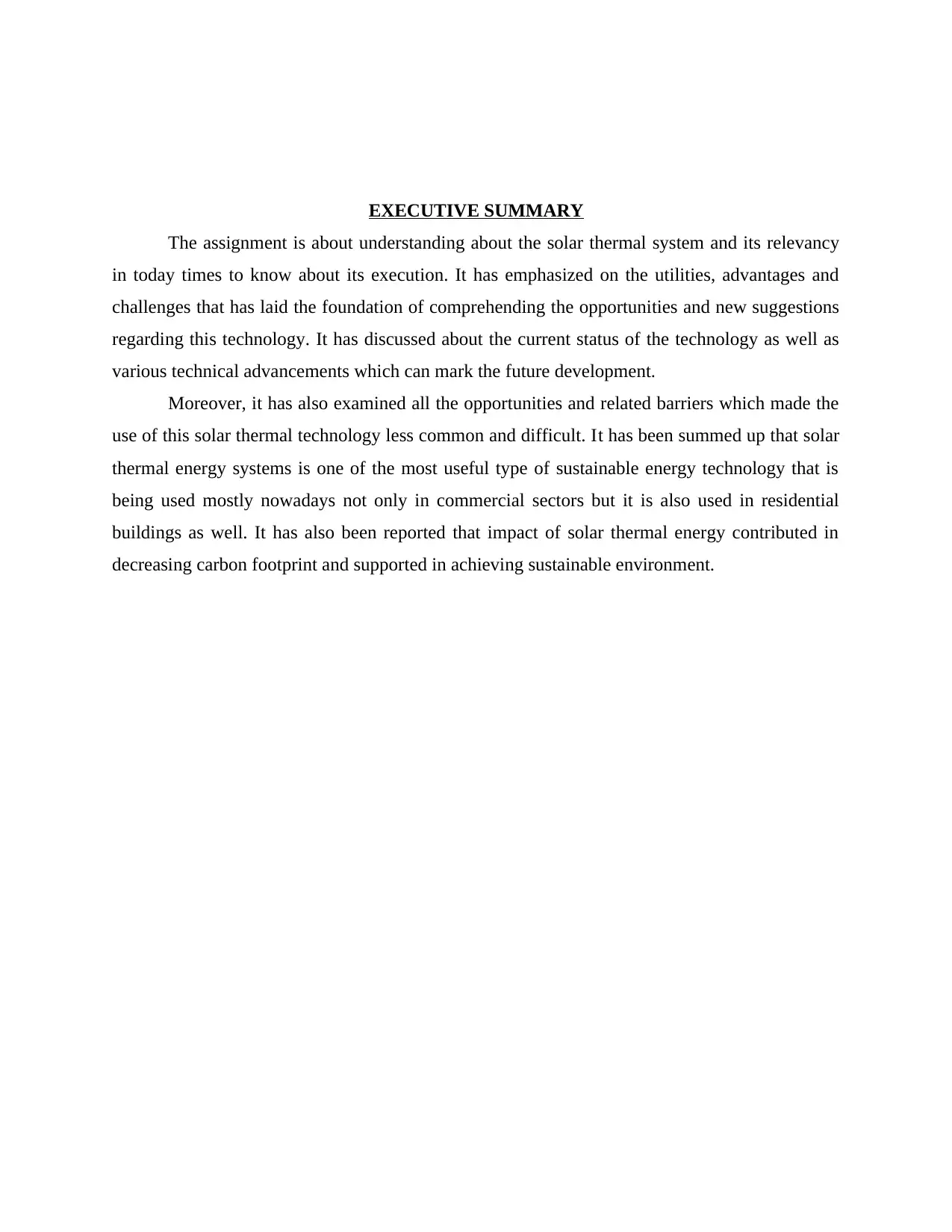
EXECUTIVE SUMMARY
The assignment is about understanding about the solar thermal system and its relevancy
in today times to know about its execution. It has emphasized on the utilities, advantages and
challenges that has laid the foundation of comprehending the opportunities and new suggestions
regarding this technology. It has discussed about the current status of the technology as well as
various technical advancements which can mark the future development.
Moreover, it has also examined all the opportunities and related barriers which made the
use of this solar thermal technology less common and difficult. It has been summed up that solar
thermal energy systems is one of the most useful type of sustainable energy technology that is
being used mostly nowadays not only in commercial sectors but it is also used in residential
buildings as well. It has also been reported that impact of solar thermal energy contributed in
decreasing carbon footprint and supported in achieving sustainable environment.
The assignment is about understanding about the solar thermal system and its relevancy
in today times to know about its execution. It has emphasized on the utilities, advantages and
challenges that has laid the foundation of comprehending the opportunities and new suggestions
regarding this technology. It has discussed about the current status of the technology as well as
various technical advancements which can mark the future development.
Moreover, it has also examined all the opportunities and related barriers which made the
use of this solar thermal technology less common and difficult. It has been summed up that solar
thermal energy systems is one of the most useful type of sustainable energy technology that is
being used mostly nowadays not only in commercial sectors but it is also used in residential
buildings as well. It has also been reported that impact of solar thermal energy contributed in
decreasing carbon footprint and supported in achieving sustainable environment.
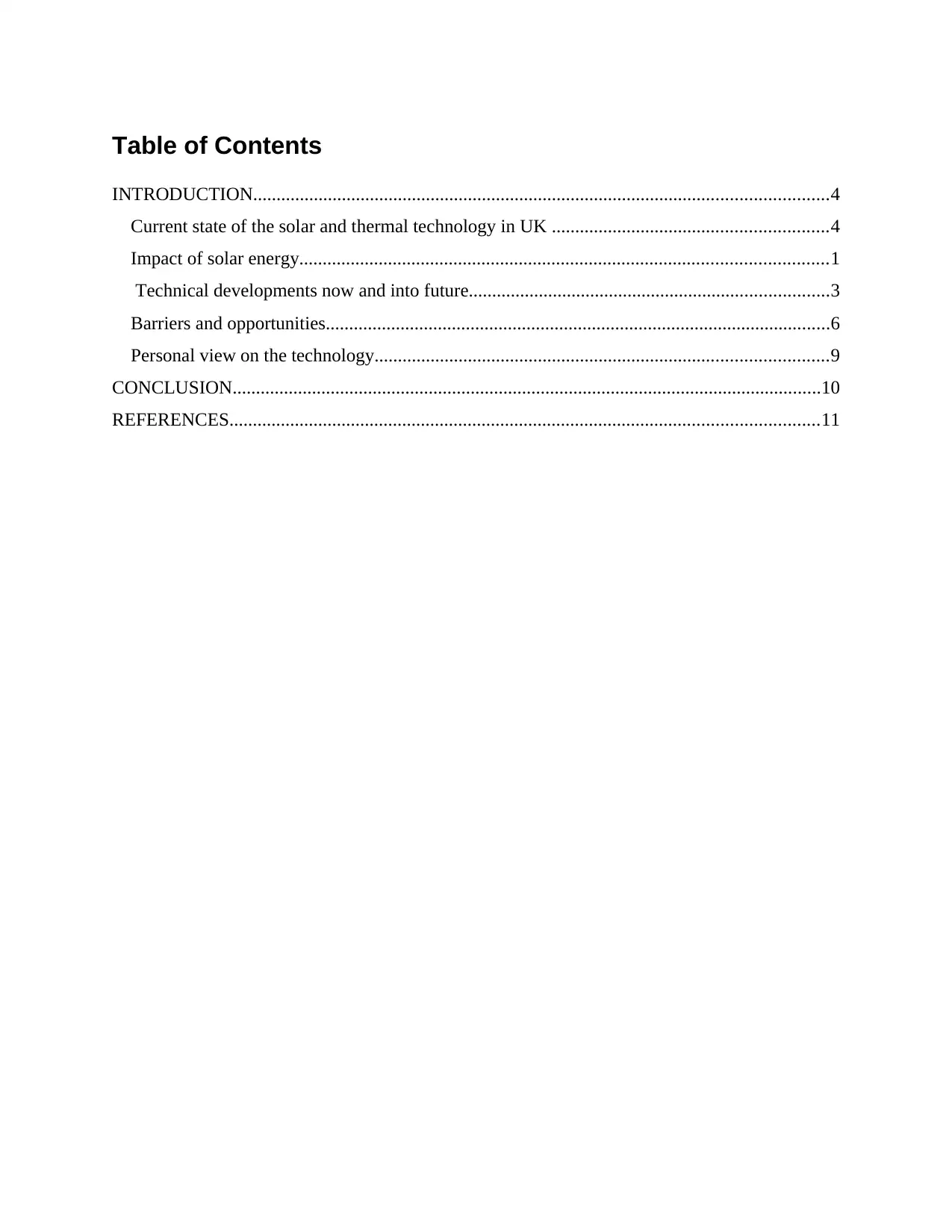
Table of Contents
INTRODUCTION...........................................................................................................................4
Current state of the solar and thermal technology in UK ...........................................................4
Impact of solar energy.................................................................................................................1
Technical developments now and into future.............................................................................3
Barriers and opportunities............................................................................................................6
Personal view on the technology.................................................................................................9
CONCLUSION..............................................................................................................................10
REFERENCES..............................................................................................................................11
INTRODUCTION...........................................................................................................................4
Current state of the solar and thermal technology in UK ...........................................................4
Impact of solar energy.................................................................................................................1
Technical developments now and into future.............................................................................3
Barriers and opportunities............................................................................................................6
Personal view on the technology.................................................................................................9
CONCLUSION..............................................................................................................................10
REFERENCES..............................................................................................................................11
⊘ This is a preview!⊘
Do you want full access?
Subscribe today to unlock all pages.

Trusted by 1+ million students worldwide
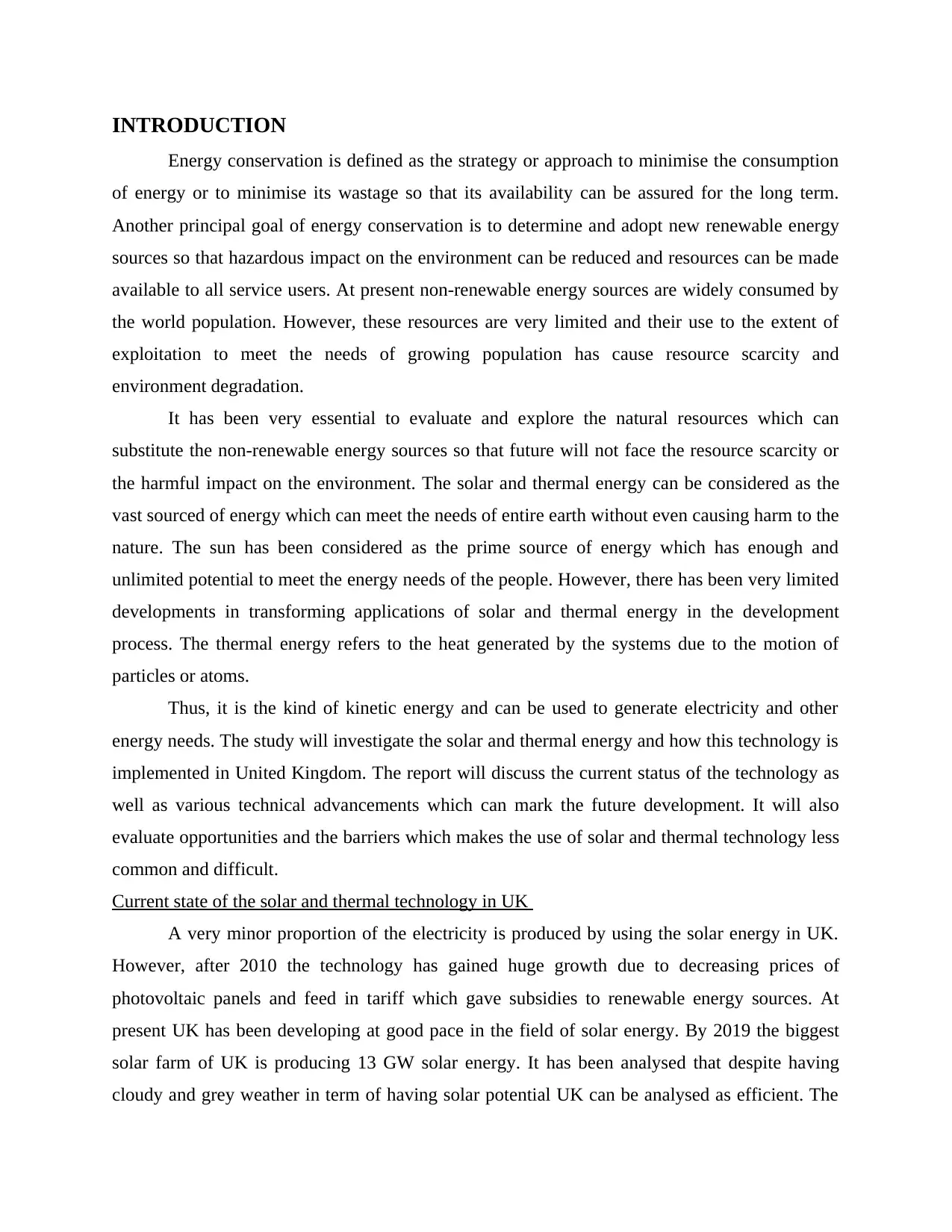
INTRODUCTION
Energy conservation is defined as the strategy or approach to minimise the consumption
of energy or to minimise its wastage so that its availability can be assured for the long term.
Another principal goal of energy conservation is to determine and adopt new renewable energy
sources so that hazardous impact on the environment can be reduced and resources can be made
available to all service users. At present non-renewable energy sources are widely consumed by
the world population. However, these resources are very limited and their use to the extent of
exploitation to meet the needs of growing population has cause resource scarcity and
environment degradation.
It has been very essential to evaluate and explore the natural resources which can
substitute the non-renewable energy sources so that future will not face the resource scarcity or
the harmful impact on the environment. The solar and thermal energy can be considered as the
vast sourced of energy which can meet the needs of entire earth without even causing harm to the
nature. The sun has been considered as the prime source of energy which has enough and
unlimited potential to meet the energy needs of the people. However, there has been very limited
developments in transforming applications of solar and thermal energy in the development
process. The thermal energy refers to the heat generated by the systems due to the motion of
particles or atoms.
Thus, it is the kind of kinetic energy and can be used to generate electricity and other
energy needs. The study will investigate the solar and thermal energy and how this technology is
implemented in United Kingdom. The report will discuss the current status of the technology as
well as various technical advancements which can mark the future development. It will also
evaluate opportunities and the barriers which makes the use of solar and thermal technology less
common and difficult.
Current state of the solar and thermal technology in UK
A very minor proportion of the electricity is produced by using the solar energy in UK.
However, after 2010 the technology has gained huge growth due to decreasing prices of
photovoltaic panels and feed in tariff which gave subsidies to renewable energy sources. At
present UK has been developing at good pace in the field of solar energy. By 2019 the biggest
solar farm of UK is producing 13 GW solar energy. It has been analysed that despite having
cloudy and grey weather in term of having solar potential UK can be analysed as efficient. The
Energy conservation is defined as the strategy or approach to minimise the consumption
of energy or to minimise its wastage so that its availability can be assured for the long term.
Another principal goal of energy conservation is to determine and adopt new renewable energy
sources so that hazardous impact on the environment can be reduced and resources can be made
available to all service users. At present non-renewable energy sources are widely consumed by
the world population. However, these resources are very limited and their use to the extent of
exploitation to meet the needs of growing population has cause resource scarcity and
environment degradation.
It has been very essential to evaluate and explore the natural resources which can
substitute the non-renewable energy sources so that future will not face the resource scarcity or
the harmful impact on the environment. The solar and thermal energy can be considered as the
vast sourced of energy which can meet the needs of entire earth without even causing harm to the
nature. The sun has been considered as the prime source of energy which has enough and
unlimited potential to meet the energy needs of the people. However, there has been very limited
developments in transforming applications of solar and thermal energy in the development
process. The thermal energy refers to the heat generated by the systems due to the motion of
particles or atoms.
Thus, it is the kind of kinetic energy and can be used to generate electricity and other
energy needs. The study will investigate the solar and thermal energy and how this technology is
implemented in United Kingdom. The report will discuss the current status of the technology as
well as various technical advancements which can mark the future development. It will also
evaluate opportunities and the barriers which makes the use of solar and thermal technology less
common and difficult.
Current state of the solar and thermal technology in UK
A very minor proportion of the electricity is produced by using the solar energy in UK.
However, after 2010 the technology has gained huge growth due to decreasing prices of
photovoltaic panels and feed in tariff which gave subsidies to renewable energy sources. At
present UK has been developing at good pace in the field of solar energy. By 2019 the biggest
solar farm of UK is producing 13 GW solar energy. It has been analysed that despite having
cloudy and grey weather in term of having solar potential UK can be analysed as efficient. The
Paraphrase This Document
Need a fresh take? Get an instant paraphrase of this document with our AI Paraphraser
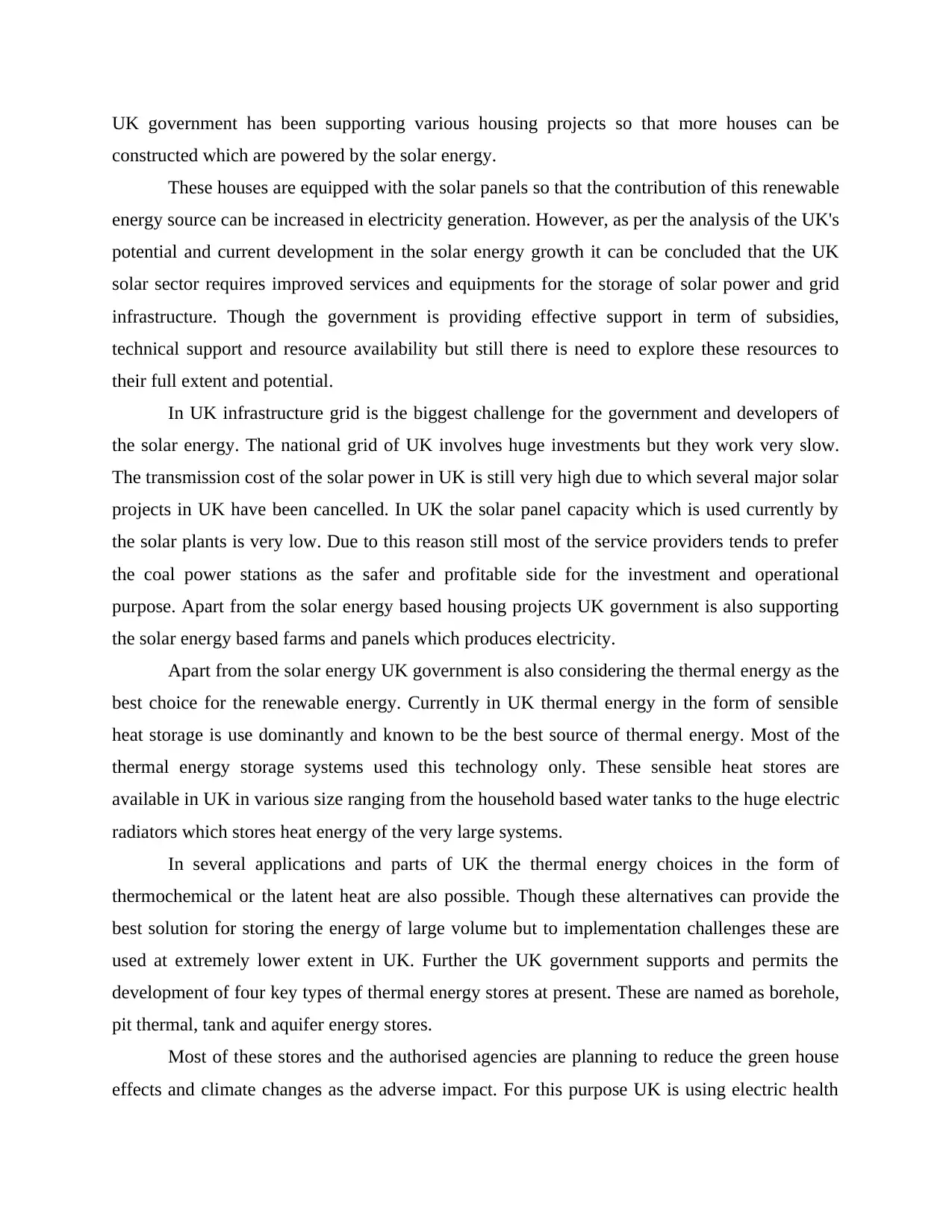
UK government has been supporting various housing projects so that more houses can be
constructed which are powered by the solar energy.
These houses are equipped with the solar panels so that the contribution of this renewable
energy source can be increased in electricity generation. However, as per the analysis of the UK's
potential and current development in the solar energy growth it can be concluded that the UK
solar sector requires improved services and equipments for the storage of solar power and grid
infrastructure. Though the government is providing effective support in term of subsidies,
technical support and resource availability but still there is need to explore these resources to
their full extent and potential.
In UK infrastructure grid is the biggest challenge for the government and developers of
the solar energy. The national grid of UK involves huge investments but they work very slow.
The transmission cost of the solar power in UK is still very high due to which several major solar
projects in UK have been cancelled. In UK the solar panel capacity which is used currently by
the solar plants is very low. Due to this reason still most of the service providers tends to prefer
the coal power stations as the safer and profitable side for the investment and operational
purpose. Apart from the solar energy based housing projects UK government is also supporting
the solar energy based farms and panels which produces electricity.
Apart from the solar energy UK government is also considering the thermal energy as the
best choice for the renewable energy. Currently in UK thermal energy in the form of sensible
heat storage is use dominantly and known to be the best source of thermal energy. Most of the
thermal energy storage systems used this technology only. These sensible heat stores are
available in UK in various size ranging from the household based water tanks to the huge electric
radiators which stores heat energy of the very large systems.
In several applications and parts of UK the thermal energy choices in the form of
thermochemical or the latent heat are also possible. Though these alternatives can provide the
best solution for storing the energy of large volume but to implementation challenges these are
used at extremely lower extent in UK. Further the UK government supports and permits the
development of four key types of thermal energy stores at present. These are named as borehole,
pit thermal, tank and aquifer energy stores.
Most of these stores and the authorised agencies are planning to reduce the green house
effects and climate changes as the adverse impact. For this purpose UK is using electric health
constructed which are powered by the solar energy.
These houses are equipped with the solar panels so that the contribution of this renewable
energy source can be increased in electricity generation. However, as per the analysis of the UK's
potential and current development in the solar energy growth it can be concluded that the UK
solar sector requires improved services and equipments for the storage of solar power and grid
infrastructure. Though the government is providing effective support in term of subsidies,
technical support and resource availability but still there is need to explore these resources to
their full extent and potential.
In UK infrastructure grid is the biggest challenge for the government and developers of
the solar energy. The national grid of UK involves huge investments but they work very slow.
The transmission cost of the solar power in UK is still very high due to which several major solar
projects in UK have been cancelled. In UK the solar panel capacity which is used currently by
the solar plants is very low. Due to this reason still most of the service providers tends to prefer
the coal power stations as the safer and profitable side for the investment and operational
purpose. Apart from the solar energy based housing projects UK government is also supporting
the solar energy based farms and panels which produces electricity.
Apart from the solar energy UK government is also considering the thermal energy as the
best choice for the renewable energy. Currently in UK thermal energy in the form of sensible
heat storage is use dominantly and known to be the best source of thermal energy. Most of the
thermal energy storage systems used this technology only. These sensible heat stores are
available in UK in various size ranging from the household based water tanks to the huge electric
radiators which stores heat energy of the very large systems.
In several applications and parts of UK the thermal energy choices in the form of
thermochemical or the latent heat are also possible. Though these alternatives can provide the
best solution for storing the energy of large volume but to implementation challenges these are
used at extremely lower extent in UK. Further the UK government supports and permits the
development of four key types of thermal energy stores at present. These are named as borehole,
pit thermal, tank and aquifer energy stores.
Most of these stores and the authorised agencies are planning to reduce the green house
effects and climate changes as the adverse impact. For this purpose UK is using electric health

pumps which uses decarbonised electricity. The stores which are used mainly with inter seasonal
approach have size suitable for only few hundred buildings in terms of cost and return. Most of
the UK building stocks are undergoing into radical transformations so that the thermal efficiency
can be improved.
It has been one of the priority of the UK government to lower the heat emissions so that
the thermal heating can be explored to new levels. For this objective the heating approaches
which have low heat emissions are used. Currently electric heat pump and district heating is
employed in United Kingdom. Both of these approaches are highly feasible in terms of cost and
transmission. It has been expected that the thermal health storage with phase change theory will
gradually dominant the UK thermal energy supply in terms of viability.
The phase change theory model is often combined or used in conjunction with the
electric air source heating pump for the domestic retrofit context. Among most of the existing
thermal system the district heating scheme in UK has been able to meet the supply and demand
of energy and is also capable to offer the buffer functioning in the maintenance. It provides
benefits and advantages to the service users as by using this technology they can have better
control and operational efficiency.
In the management and supply of UK thermal energy the heat transition with low carbon
environment is critical and challenging aspect. At present the UK heating network are providing
only two percent of the UK's total heating supply. The expansion of these heating network is
possible in various regions of UK which have greater demand of the heat energy. However, its
installation cost is still very high in UK and thus the financial perspective makes it hard to help
this energy resources in growth.
approach have size suitable for only few hundred buildings in terms of cost and return. Most of
the UK building stocks are undergoing into radical transformations so that the thermal efficiency
can be improved.
It has been one of the priority of the UK government to lower the heat emissions so that
the thermal heating can be explored to new levels. For this objective the heating approaches
which have low heat emissions are used. Currently electric heat pump and district heating is
employed in United Kingdom. Both of these approaches are highly feasible in terms of cost and
transmission. It has been expected that the thermal health storage with phase change theory will
gradually dominant the UK thermal energy supply in terms of viability.
The phase change theory model is often combined or used in conjunction with the
electric air source heating pump for the domestic retrofit context. Among most of the existing
thermal system the district heating scheme in UK has been able to meet the supply and demand
of energy and is also capable to offer the buffer functioning in the maintenance. It provides
benefits and advantages to the service users as by using this technology they can have better
control and operational efficiency.
In the management and supply of UK thermal energy the heat transition with low carbon
environment is critical and challenging aspect. At present the UK heating network are providing
only two percent of the UK's total heating supply. The expansion of these heating network is
possible in various regions of UK which have greater demand of the heat energy. However, its
installation cost is still very high in UK and thus the financial perspective makes it hard to help
this energy resources in growth.
⊘ This is a preview!⊘
Do you want full access?
Subscribe today to unlock all pages.

Trusted by 1+ million students worldwide
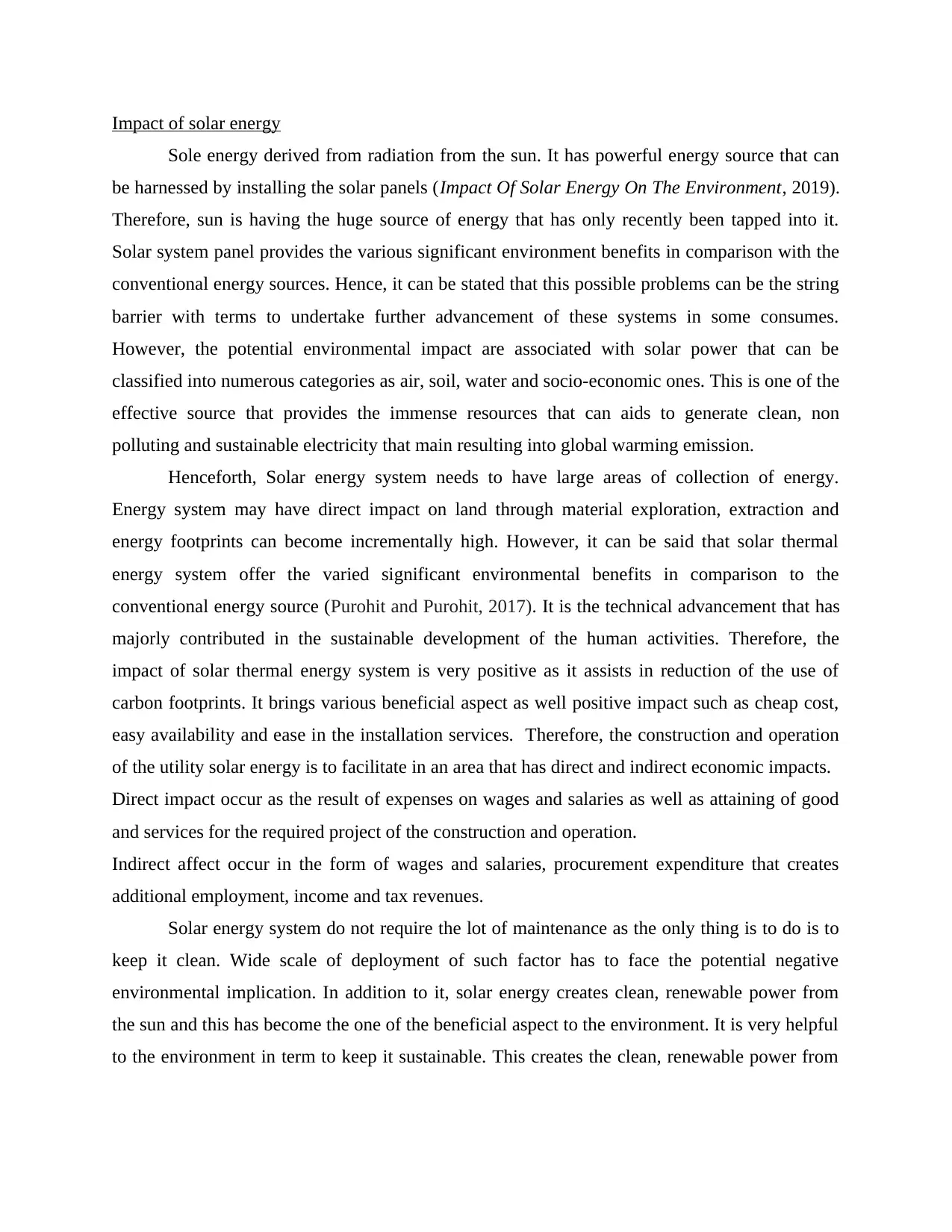
Impact of solar energy
Sole energy derived from radiation from the sun. It has powerful energy source that can
be harnessed by installing the solar panels (Impact Of Solar Energy On The Environment, 2019).
Therefore, sun is having the huge source of energy that has only recently been tapped into it.
Solar system panel provides the various significant environment benefits in comparison with the
conventional energy sources. Hence, it can be stated that this possible problems can be the string
barrier with terms to undertake further advancement of these systems in some consumes.
However, the potential environmental impact are associated with solar power that can be
classified into numerous categories as air, soil, water and socio-economic ones. This is one of the
effective source that provides the immense resources that can aids to generate clean, non
polluting and sustainable electricity that main resulting into global warming emission.
Henceforth, Solar energy system needs to have large areas of collection of energy.
Energy system may have direct impact on land through material exploration, extraction and
energy footprints can become incrementally high. However, it can be said that solar thermal
energy system offer the varied significant environmental benefits in comparison to the
conventional energy source (Purohit and Purohit, 2017). It is the technical advancement that has
majorly contributed in the sustainable development of the human activities. Therefore, the
impact of solar thermal energy system is very positive as it assists in reduction of the use of
carbon footprints. It brings various beneficial aspect as well positive impact such as cheap cost,
easy availability and ease in the installation services. Therefore, the construction and operation
of the utility solar energy is to facilitate in an area that has direct and indirect economic impacts.
Direct impact occur as the result of expenses on wages and salaries as well as attaining of good
and services for the required project of the construction and operation.
Indirect affect occur in the form of wages and salaries, procurement expenditure that creates
additional employment, income and tax revenues.
Solar energy system do not require the lot of maintenance as the only thing is to do is to
keep it clean. Wide scale of deployment of such factor has to face the potential negative
environmental implication. In addition to it, solar energy creates clean, renewable power from
the sun and this has become the one of the beneficial aspect to the environment. It is very helpful
to the environment in term to keep it sustainable. This creates the clean, renewable power from
Sole energy derived from radiation from the sun. It has powerful energy source that can
be harnessed by installing the solar panels (Impact Of Solar Energy On The Environment, 2019).
Therefore, sun is having the huge source of energy that has only recently been tapped into it.
Solar system panel provides the various significant environment benefits in comparison with the
conventional energy sources. Hence, it can be stated that this possible problems can be the string
barrier with terms to undertake further advancement of these systems in some consumes.
However, the potential environmental impact are associated with solar power that can be
classified into numerous categories as air, soil, water and socio-economic ones. This is one of the
effective source that provides the immense resources that can aids to generate clean, non
polluting and sustainable electricity that main resulting into global warming emission.
Henceforth, Solar energy system needs to have large areas of collection of energy.
Energy system may have direct impact on land through material exploration, extraction and
energy footprints can become incrementally high. However, it can be said that solar thermal
energy system offer the varied significant environmental benefits in comparison to the
conventional energy source (Purohit and Purohit, 2017). It is the technical advancement that has
majorly contributed in the sustainable development of the human activities. Therefore, the
impact of solar thermal energy system is very positive as it assists in reduction of the use of
carbon footprints. It brings various beneficial aspect as well positive impact such as cheap cost,
easy availability and ease in the installation services. Therefore, the construction and operation
of the utility solar energy is to facilitate in an area that has direct and indirect economic impacts.
Direct impact occur as the result of expenses on wages and salaries as well as attaining of good
and services for the required project of the construction and operation.
Indirect affect occur in the form of wages and salaries, procurement expenditure that creates
additional employment, income and tax revenues.
Solar energy system do not require the lot of maintenance as the only thing is to do is to
keep it clean. Wide scale of deployment of such factor has to face the potential negative
environmental implication. In addition to it, solar energy creates clean, renewable power from
the sun and this has become the one of the beneficial aspect to the environment. It is very helpful
to the environment in term to keep it sustainable. This creates the clean, renewable power from
Paraphrase This Document
Need a fresh take? Get an instant paraphrase of this document with our AI Paraphraser

sun and beneficial in terms to the environment. Solar power energy system derive clean and
purest energy from the sun.
purest energy from the sun.
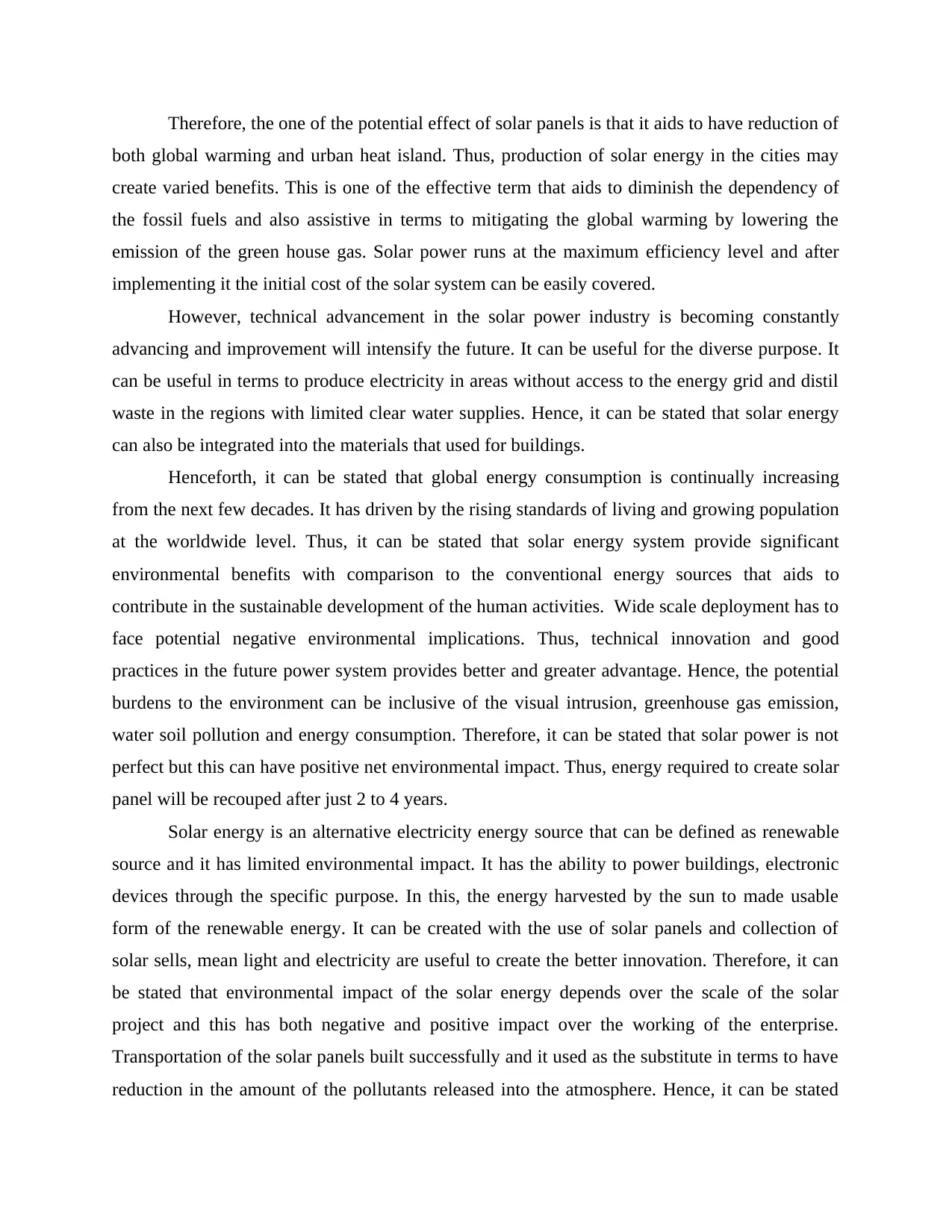
Therefore, the one of the potential effect of solar panels is that it aids to have reduction of
both global warming and urban heat island. Thus, production of solar energy in the cities may
create varied benefits. This is one of the effective term that aids to diminish the dependency of
the fossil fuels and also assistive in terms to mitigating the global warming by lowering the
emission of the green house gas. Solar power runs at the maximum efficiency level and after
implementing it the initial cost of the solar system can be easily covered.
However, technical advancement in the solar power industry is becoming constantly
advancing and improvement will intensify the future. It can be useful for the diverse purpose. It
can be useful in terms to produce electricity in areas without access to the energy grid and distil
waste in the regions with limited clear water supplies. Hence, it can be stated that solar energy
can also be integrated into the materials that used for buildings.
Henceforth, it can be stated that global energy consumption is continually increasing
from the next few decades. It has driven by the rising standards of living and growing population
at the worldwide level. Thus, it can be stated that solar energy system provide significant
environmental benefits with comparison to the conventional energy sources that aids to
contribute in the sustainable development of the human activities. Wide scale deployment has to
face potential negative environmental implications. Thus, technical innovation and good
practices in the future power system provides better and greater advantage. Hence, the potential
burdens to the environment can be inclusive of the visual intrusion, greenhouse gas emission,
water soil pollution and energy consumption. Therefore, it can be stated that solar power is not
perfect but this can have positive net environmental impact. Thus, energy required to create solar
panel will be recouped after just 2 to 4 years.
Solar energy is an alternative electricity energy source that can be defined as renewable
source and it has limited environmental impact. It has the ability to power buildings, electronic
devices through the specific purpose. In this, the energy harvested by the sun to made usable
form of the renewable energy. It can be created with the use of solar panels and collection of
solar sells, mean light and electricity are useful to create the better innovation. Therefore, it can
be stated that environmental impact of the solar energy depends over the scale of the solar
project and this has both negative and positive impact over the working of the enterprise.
Transportation of the solar panels built successfully and it used as the substitute in terms to have
reduction in the amount of the pollutants released into the atmosphere. Hence, it can be stated
both global warming and urban heat island. Thus, production of solar energy in the cities may
create varied benefits. This is one of the effective term that aids to diminish the dependency of
the fossil fuels and also assistive in terms to mitigating the global warming by lowering the
emission of the green house gas. Solar power runs at the maximum efficiency level and after
implementing it the initial cost of the solar system can be easily covered.
However, technical advancement in the solar power industry is becoming constantly
advancing and improvement will intensify the future. It can be useful for the diverse purpose. It
can be useful in terms to produce electricity in areas without access to the energy grid and distil
waste in the regions with limited clear water supplies. Hence, it can be stated that solar energy
can also be integrated into the materials that used for buildings.
Henceforth, it can be stated that global energy consumption is continually increasing
from the next few decades. It has driven by the rising standards of living and growing population
at the worldwide level. Thus, it can be stated that solar energy system provide significant
environmental benefits with comparison to the conventional energy sources that aids to
contribute in the sustainable development of the human activities. Wide scale deployment has to
face potential negative environmental implications. Thus, technical innovation and good
practices in the future power system provides better and greater advantage. Hence, the potential
burdens to the environment can be inclusive of the visual intrusion, greenhouse gas emission,
water soil pollution and energy consumption. Therefore, it can be stated that solar power is not
perfect but this can have positive net environmental impact. Thus, energy required to create solar
panel will be recouped after just 2 to 4 years.
Solar energy is an alternative electricity energy source that can be defined as renewable
source and it has limited environmental impact. It has the ability to power buildings, electronic
devices through the specific purpose. In this, the energy harvested by the sun to made usable
form of the renewable energy. It can be created with the use of solar panels and collection of
solar sells, mean light and electricity are useful to create the better innovation. Therefore, it can
be stated that environmental impact of the solar energy depends over the scale of the solar
project and this has both negative and positive impact over the working of the enterprise.
Transportation of the solar panels built successfully and it used as the substitute in terms to have
reduction in the amount of the pollutants released into the atmosphere. Hence, it can be stated
⊘ This is a preview!⊘
Do you want full access?
Subscribe today to unlock all pages.

Trusted by 1+ million students worldwide
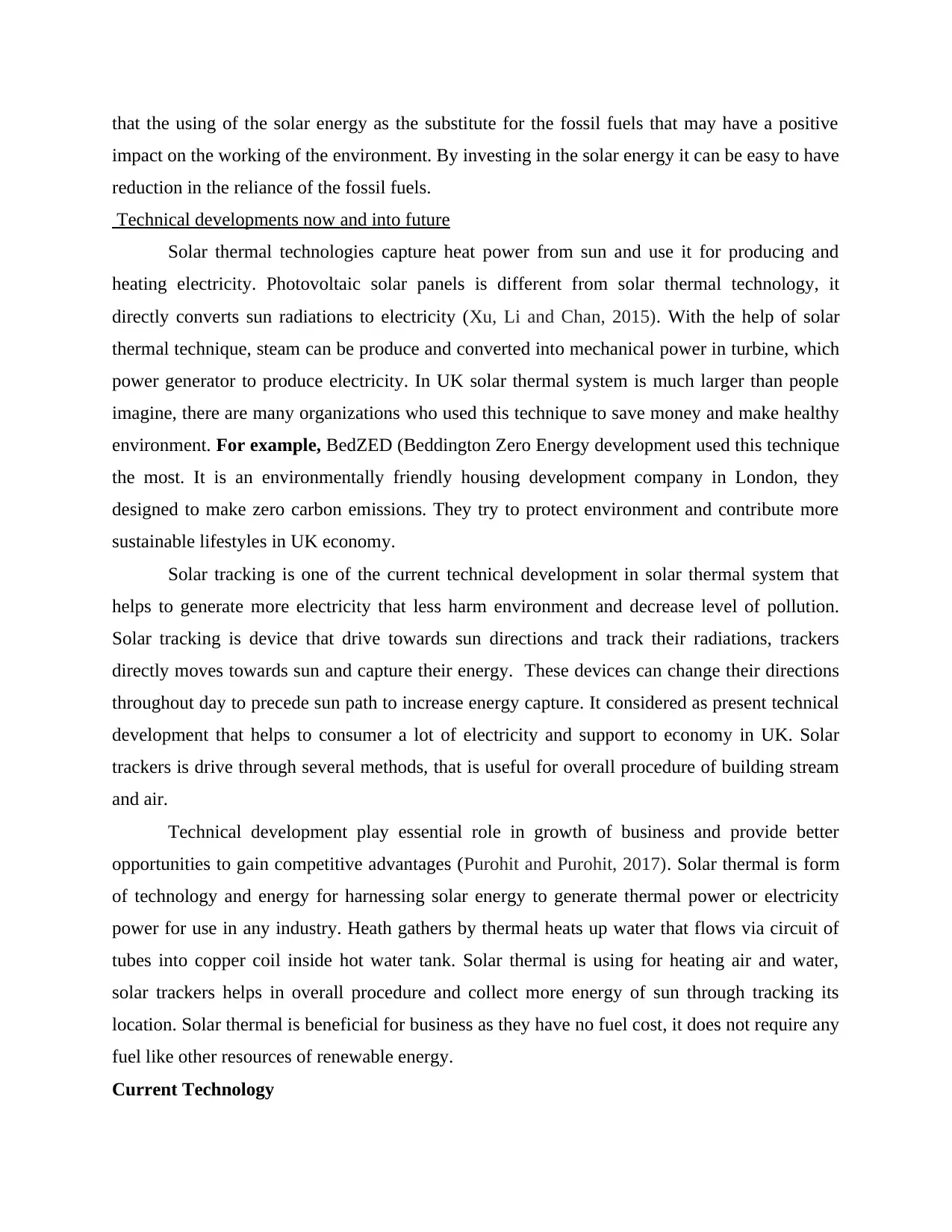
that the using of the solar energy as the substitute for the fossil fuels that may have a positive
impact on the working of the environment. By investing in the solar energy it can be easy to have
reduction in the reliance of the fossil fuels.
Technical developments now and into future
Solar thermal technologies capture heat power from sun and use it for producing and
heating electricity. Photovoltaic solar panels is different from solar thermal technology, it
directly converts sun radiations to electricity (Xu, Li and Chan, 2015). With the help of solar
thermal technique, steam can be produce and converted into mechanical power in turbine, which
power generator to produce electricity. In UK solar thermal system is much larger than people
imagine, there are many organizations who used this technique to save money and make healthy
environment. For example, BedZED (Beddington Zero Energy development used this technique
the most. It is an environmentally friendly housing development company in London, they
designed to make zero carbon emissions. They try to protect environment and contribute more
sustainable lifestyles in UK economy.
Solar tracking is one of the current technical development in solar thermal system that
helps to generate more electricity that less harm environment and decrease level of pollution.
Solar tracking is device that drive towards sun directions and track their radiations, trackers
directly moves towards sun and capture their energy. These devices can change their directions
throughout day to precede sun path to increase energy capture. It considered as present technical
development that helps to consumer a lot of electricity and support to economy in UK. Solar
trackers is drive through several methods, that is useful for overall procedure of building stream
and air.
Technical development play essential role in growth of business and provide better
opportunities to gain competitive advantages (Purohit and Purohit, 2017). Solar thermal is form
of technology and energy for harnessing solar energy to generate thermal power or electricity
power for use in any industry. Heath gathers by thermal heats up water that flows via circuit of
tubes into copper coil inside hot water tank. Solar thermal is using for heating air and water,
solar trackers helps in overall procedure and collect more energy of sun through tracking its
location. Solar thermal is beneficial for business as they have no fuel cost, it does not require any
fuel like other resources of renewable energy.
Current Technology
impact on the working of the environment. By investing in the solar energy it can be easy to have
reduction in the reliance of the fossil fuels.
Technical developments now and into future
Solar thermal technologies capture heat power from sun and use it for producing and
heating electricity. Photovoltaic solar panels is different from solar thermal technology, it
directly converts sun radiations to electricity (Xu, Li and Chan, 2015). With the help of solar
thermal technique, steam can be produce and converted into mechanical power in turbine, which
power generator to produce electricity. In UK solar thermal system is much larger than people
imagine, there are many organizations who used this technique to save money and make healthy
environment. For example, BedZED (Beddington Zero Energy development used this technique
the most. It is an environmentally friendly housing development company in London, they
designed to make zero carbon emissions. They try to protect environment and contribute more
sustainable lifestyles in UK economy.
Solar tracking is one of the current technical development in solar thermal system that
helps to generate more electricity that less harm environment and decrease level of pollution.
Solar tracking is device that drive towards sun directions and track their radiations, trackers
directly moves towards sun and capture their energy. These devices can change their directions
throughout day to precede sun path to increase energy capture. It considered as present technical
development that helps to consumer a lot of electricity and support to economy in UK. Solar
trackers is drive through several methods, that is useful for overall procedure of building stream
and air.
Technical development play essential role in growth of business and provide better
opportunities to gain competitive advantages (Purohit and Purohit, 2017). Solar thermal is form
of technology and energy for harnessing solar energy to generate thermal power or electricity
power for use in any industry. Heath gathers by thermal heats up water that flows via circuit of
tubes into copper coil inside hot water tank. Solar thermal is using for heating air and water,
solar trackers helps in overall procedure and collect more energy of sun through tracking its
location. Solar thermal is beneficial for business as they have no fuel cost, it does not require any
fuel like other resources of renewable energy.
Current Technology
Paraphrase This Document
Need a fresh take? Get an instant paraphrase of this document with our AI Paraphraser
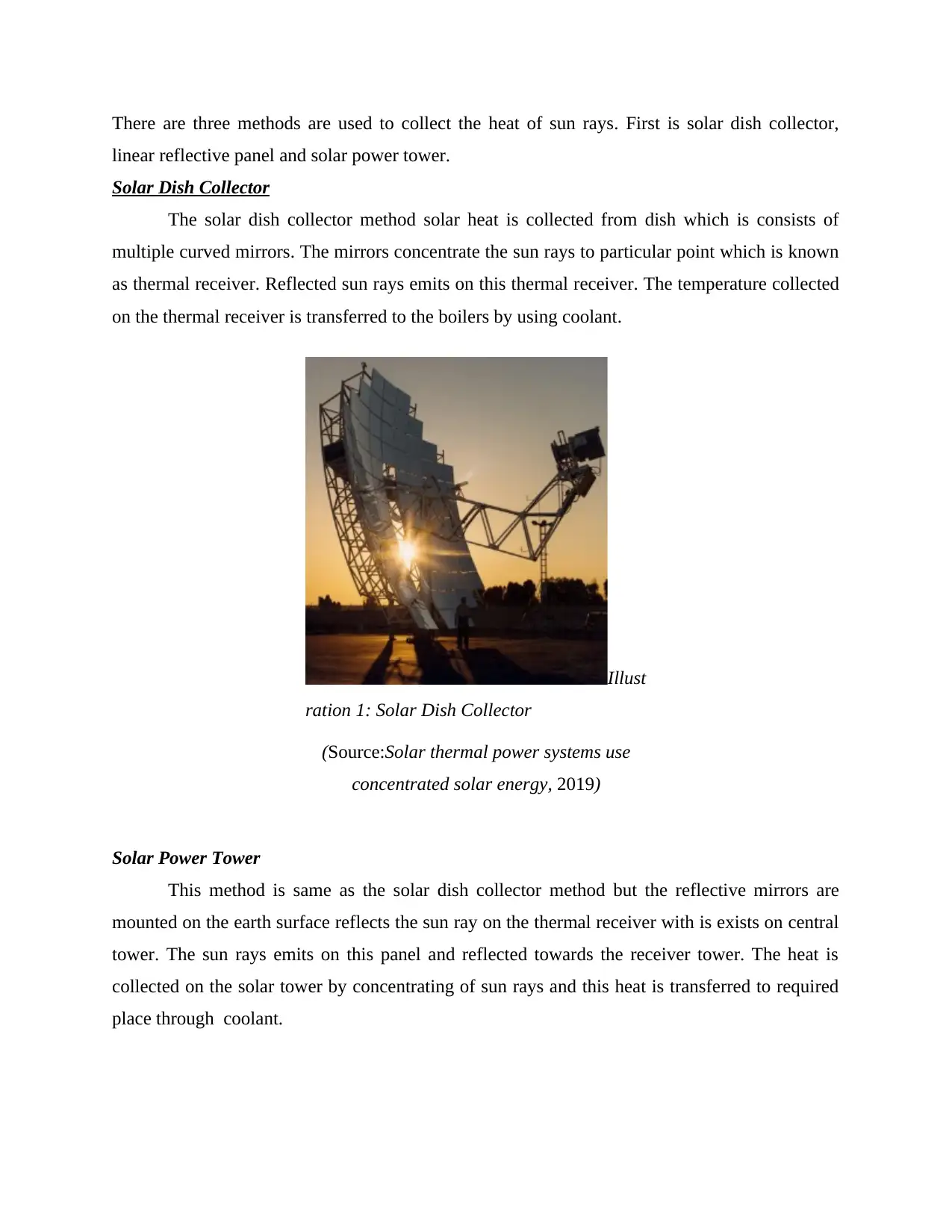
There are three methods are used to collect the heat of sun rays. First is solar dish collector,
linear reflective panel and solar power tower.
Solar Dish Collector
The solar dish collector method solar heat is collected from dish which is consists of
multiple curved mirrors. The mirrors concentrate the sun rays to particular point which is known
as thermal receiver. Reflected sun rays emits on this thermal receiver. The temperature collected
on the thermal receiver is transferred to the boilers by using coolant.
Solar Power Tower
This method is same as the solar dish collector method but the reflective mirrors are
mounted on the earth surface reflects the sun ray on the thermal receiver with is exists on central
tower. The sun rays emits on this panel and reflected towards the receiver tower. The heat is
collected on the solar tower by concentrating of sun rays and this heat is transferred to required
place through coolant.
Illust
ration 1: Solar Dish Collector
(Source:Solar thermal power systems use
concentrated solar energy, 2019)
linear reflective panel and solar power tower.
Solar Dish Collector
The solar dish collector method solar heat is collected from dish which is consists of
multiple curved mirrors. The mirrors concentrate the sun rays to particular point which is known
as thermal receiver. Reflected sun rays emits on this thermal receiver. The temperature collected
on the thermal receiver is transferred to the boilers by using coolant.
Solar Power Tower
This method is same as the solar dish collector method but the reflective mirrors are
mounted on the earth surface reflects the sun ray on the thermal receiver with is exists on central
tower. The sun rays emits on this panel and reflected towards the receiver tower. The heat is
collected on the solar tower by concentrating of sun rays and this heat is transferred to required
place through coolant.
Illust
ration 1: Solar Dish Collector
(Source:Solar thermal power systems use
concentrated solar energy, 2019)
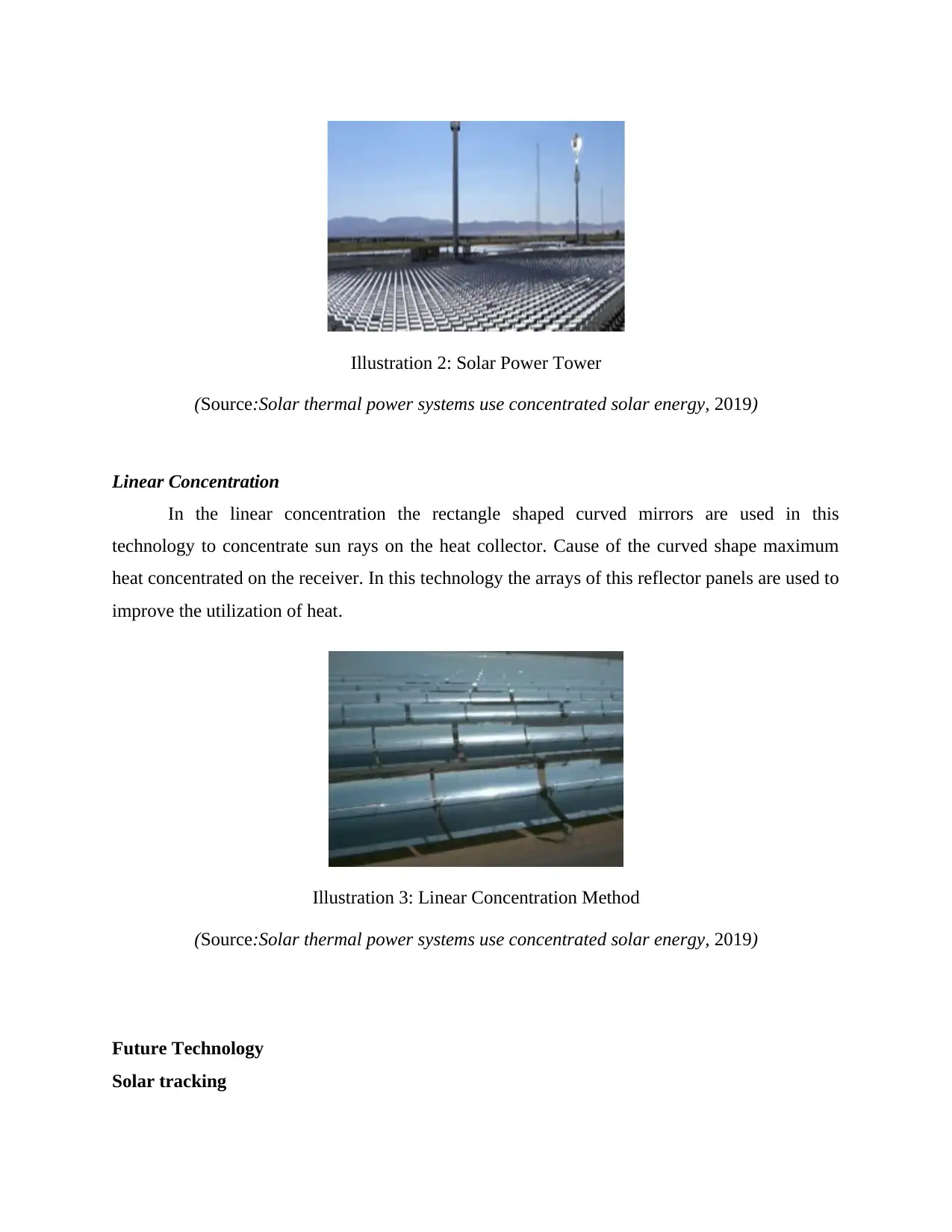
Linear Concentration
In the linear concentration the rectangle shaped curved mirrors are used in this
technology to concentrate sun rays on the heat collector. Cause of the curved shape maximum
heat concentrated on the receiver. In this technology the arrays of this reflector panels are used to
improve the utilization of heat.
Future Technology
Solar tracking
Illustration 2: Solar Power Tower
(Source:Solar thermal power systems use concentrated solar energy, 2019)
Illustration 3: Linear Concentration Method
(Source:Solar thermal power systems use concentrated solar energy, 2019)
In the linear concentration the rectangle shaped curved mirrors are used in this
technology to concentrate sun rays on the heat collector. Cause of the curved shape maximum
heat concentrated on the receiver. In this technology the arrays of this reflector panels are used to
improve the utilization of heat.
Future Technology
Solar tracking
Illustration 2: Solar Power Tower
(Source:Solar thermal power systems use concentrated solar energy, 2019)
Illustration 3: Linear Concentration Method
(Source:Solar thermal power systems use concentrated solar energy, 2019)
⊘ This is a preview!⊘
Do you want full access?
Subscribe today to unlock all pages.

Trusted by 1+ million students worldwide
1 out of 20
Related Documents
Your All-in-One AI-Powered Toolkit for Academic Success.
+13062052269
info@desklib.com
Available 24*7 on WhatsApp / Email
![[object Object]](/_next/static/media/star-bottom.7253800d.svg)
Unlock your academic potential
Copyright © 2020–2025 A2Z Services. All Rights Reserved. Developed and managed by ZUCOL.



